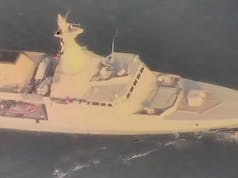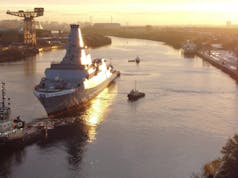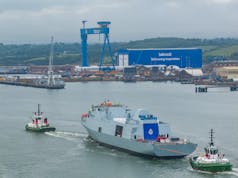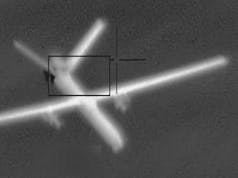At LIMA 2017, Commander UK Maritime Forces Rear Admiral Alex Burton described the Type 26 Frigate and its range of capabilities in a bid to talk the vessel up to Australian officials.
“The government has committed to eight Type 26 ships and they will be the mainstay of our anti-submarine warfare capability, both to project the continuous at-sea deterrence and to project what I’ve often described as the strategic conventional deterrence of the carrier task group.
The Type 26 will undoubtedly be the most capable ASW afloat, arriving early next decade. But it’s so much more than an ASW platform, with the ability to take Tomahawk strike missiles, a 5-inch gun and a considerable local area defence capability; and the mission bay, which can take a whole range of mission support packages.”
Despite recent sensationalism in the press, the Type 26 Frigate fleet will be armed with Sea Ceptor missiles with additional types to be carried decided at a later date.
The issue at the heart of the recent speculation is the fact that no weapons have yet been ordered or are in service that can be launched from the Mk41 Vertical Launch Silo system to be installed on the vessels, however the vessel will also carry Sea Ceptor missiles contained in separate silos.
Various media outlets have reported mostly sensationalised stories about the ships, the most notable of which was the Times saying in its absurdly titled article ‘Misfire as new navy ships lack missiles’:
“A navy programme to build a fleet of new warships at a cost of £8bn has been branded a ‘dog’s breakfast’ after it emerged the ships would have missile-launching tubes — but Britain has no missiles to fire from them.”
A Royal Naval spokesman said:
“The Type 26 Frigate will be delivered with cutting edge weapons and sensors that build on the excellent operational record of the Type 23.
Backed by a rising defence budget and a £178 billion equipment plan, investment in the MK 41 launcher enables the Royal Navy the option of investing in a wide range of additional capabilities at short notice and according to the threat.”
This indicates that nothing, as of yet, has been ordered.
This does make sense, the first vessel is some years away from sea trials, let alone operational service. Ordering so far in advance would likely prove to be a futile effort, wasting money that would benefit other programmes and initiatives.
The view being taken, that it’s best to wait and see what emerges before committing to and paying for a missile type years before it is required, is the right one.
As explained above, the Type 26 will have Sea Ceptor silo’s on the bow and at the funnel of the vessel in addition to a 24 cell Mk 41 silo positioned behind the Sea Ceptor silo’s on the bow of the vessel. The 24-cell strike-length Mk 41 VLS will be able to host Tomahawk cruise missiles, ASROC anti-submarine rocks and LRASM, the Long Range Anti-ship Missile.
The true test of whether or not the Mk 41 silo will host these is if they are ordered closer to the vessels entering service, around the 2020 Strategic Defence and Security Review.













I’m going to guess for the Australian version, they’d want a second Mk 41 VLS, rather than a second Sea Ceptor silo – if it can be fitted in.
I agree re likely Australian version. Someone who seemed to know what he was talking about in another forum (although it’s impossible to know for sure if people really are insiders) said a while back that the T-26 did have design provision for an all strike-length-Mk41 forward silo. I think 48 was the number mentioned.
If the T-26 ever became the basis for T-45 replacement it would also make sense to do that for those UK ones, 48 strike-length launchers forward so that the AAW variants can pack a lot more of whatever longer range and ABM missiles are around at the time. In fact given that Sea Ceptor can be quad-packed into MK41 I’d quite like to see all UK T-26 with all strike length up front and Sea Ceptor soft launch for the funnel area.
At the moment it’s just a paper project.
Several years of design and redesign, but nothing else to show to potential customers apart from fancy CGIs.
In 2010 this was promoted as an international project will several nations viewed as likely partners to share the cost of design and development, a warship version of the F35 project. To date not a single partner has been found.
RN requirement cut from 13 to 8 vessels, thereby increasing the cost per ship.
The Australian frigate project looks interesting, but the Italian FREMM frigate must be favourite as it is already in service and therefore significantly lower risk than a paper project like the T26.
Despite our grand thinking i consider the T26 may eventually end up as a UK only project with no exports continuing a 40 year old track record of export and therefore economic failure.
Without exports there is no future for the UK warship building industry.
Secondly recent press reports about new Russian anti ship missiles and it’s claimed performance make the seaceptor missile system ineffective against such weapons
Something else to think about for the future.
aussies will go with navatia frigate. commonality with the awd, and the tankers they just ordered as well. it will be a spanish armada down under
We built two carriers without aircraft so whats the problem building frigates with missile tubes but no missiles…. That’s life in a blue suit!!!
Even if the type 26 does emerge completed and in service as planned. Only having 8 high end capable frigates is inadequate.
The type 31 needs to fill the gap. Thus RN needs at least 10 type 31 hulls.
just seen a really good design by stellar systems. Much more capable and adaptable then the BMT venator design.
crucially the Stellar systems design is expandable with space to be uparmed and made more powerfull during its service life. Really like the design. Large hangar, medium gun, sea ceptor , Phalanx 1B, containerised anti ship missiles of NSM type. Excellent just what the RN needs. If we could just get 10 of these ships we would be returning critical mass to an overstretched, under manned RN.
Look up Stellar systems Spartan design.
I am impressed by the wishful thinking of people in the UK about the Type 26 being selected for Australia.
The arguments advanced about the advantages of different sensor and weapons fits are largely moot since they are, for all intents and purposes, required to be common for each of the three bidders.
For example, regardless of the winning bidder, the radars will be the Australian built phased array radar from CEA for two reasons. Firstly no Australian government in their right mind that is arguing for developing an advanced manufacturing sector and protecting Australian jobs, not to mention the millions already poured into the CEA project and the cooperative development agreement signed with the US, would opt for another system.
Secondly it is one of the most advanced radars of its kind and has already given the existing eight ANZAC frigates (in combination with the ESSM missile) a proven capability to intercept multiple supersonic cruise missiles. Their capability is akin to an AEGIS-lite and superior to the existing Type 23’s air defence capabilities by a significant margin. If you have any doubts about the radar being proposed for the Type 26 Australian bid, have a look at the BAE renders and compare them to the ANZACS – that’s clearly a CEA radar on the mast.
Similarly proposing Sea Ceptor is also a losing argument. There may be a number of orders from different navies, but it is not a proven system in widespread service (or anywhere yet?). Why would Australia want to select a missile that is slower than ESSM (Mach3 vs Mach 4 – severely reducing reaction times), with half the range of an ESSM (even the Sea Ceptor ER version won’t match the ESSMs range). Sea Ceptor’s only technical advantage, its independent seeker, is now matched by the ESSM Block II while both types can be quad packed in a VLS cell.
A small navy like the RAN cannot afford to (and will not) adopt ‘orphan’ weapons systems for its frigates that are different to the Hobart Class AWDs. The Raytheon (ESSM, SM2, SM3, SM6) products are proven, their upgrades are effectively guaranteed and paid for by the USN and they enable interoperability with the US, our major ally.
The combat system will almost certainly be the scalable SAAB 9LV which is already in service on the ANZACS and integrated with the CEA radar, plus it’s the specified combat system on the Canberra Class LHDs and new Navantnia built replenishment ships and potentially the 12 new OPVs. This common platform represents a significant saving in procurement, training simulators and integration costs.
There is a significant aversion now in the ADF to the procurement of first of class ‘paper platforms’. Australia was burnt by the protracted procurement and integration issues of the Wedgetail AWACS, the Airbus KC30 tanker and the Eurocopter Tiger, not to mention the Seasprite debacle. The on time, on budget experience of recent off-the-shelf MOTS buys by the ADF including the C17, Super Hornet, Growler, P8 and Sikorsky Romeos all underscore this new mindset.
This places the Type 26 at a significant disadvantage, given it is likely to be a number of years before one of the type is in the water. If the UK bid had any kind of advantage I’d argue that it was in the perception of superior ship design and engineering. However, this image has been severely tarnished by the ongoing problems with Type 45’s unreliable propulsion systems, not to mention the RAN’s recent experience with having to replace major propulsion components on the Bay Class LPD HMAS Choules.
Both the Italians and the Spaniards have been able to sail versions of their designs down under to exercise with the RAN. The Italian ship is impressively quiet by all accounts with the RAN engineers able to take real world and verifiable measurements of the ship underway (and no doubt from a Collins submarine sonar underwater).
The experience with Spanish shipbuilder Navantia is now mature, supply chains well established and there is a significant amount of commonality of systems with the Hobart AWDs, although its propulsion system is likely to be different and untested and reliant on ‘brochure’ data like the Type 26. Navantia’s SEA 5000 design is based on the Hobart Class AWD which already accommodates 48 strike length VLS cells
Ironically, if the Type 26 was to win (and there was snow in the Simpson Desert) Australia, with nine frigates, would be the largest operator of the type.
That is unless of course the Type 26 became the victor in the shambolic Canadian new frigate program with an order for ‘up to 15’ ships. Given that they changed their previously firm MOTS only rule specifically to accommodate the T26 that is now increasingly likely. Though the UK should be careful what it wishes for.
http://news.nationalpost.com/news/canada/canadian-warship-project-a-mess-minister-told-as-one-of-worlds-largest-shipbuilders-threatens-not-to-bid
Paradoxically a Canadian win by BAE would be another reason for Australia not to choose the T26. The potentially much larger Canadian order could limit or in a worse case dictate the Type 26’s specification for the RAN. Though of course the RN variant could face the same problem of the tail wagging the dog.
@Oscar Zulu – “Why would Australia want to select a missile that is slower than ESSM (Mach3 vs Mach 4 – severely reducing reaction times), with half the range of an ESSM (even the Sea Ceptor ER version won’t match the ESSMs range). ”
I think cost and politics will give the Sea Ceptor a chance in being chosen. Sea Ceptor will be (in my opinion) cheaper than what the Americans will offer and the Australian Government could use the purchase of buying Sea Ceptor to aid in future trade talks with a post Brexit Britain. Time will tell…